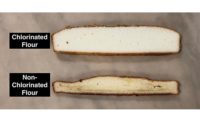The fermentation of dough leads to a strengthening of the dough matrix. Dough conditioners and oxidizers like azodicarbonamide (ADA), bromate and ascorbic acid, as well as their enzyme counterparts, lead to the strengthening of the dough matrix. So can you use fermentation to clean up the bread label?
Yes, you can! Unfortunately, the reality of this happening is overshadowed by the inability to extend your fermentation systems due to the need for capital investments. And if fermentation is the cure-all to clean up labels, why isn’t everybody doing it?
Let’s take a walk back in time, where almost every bakery had a sponge and dough room where sponges ferment for over four hours before they were used. Back then, almost everyone used matured flour and no one harped on throughput and efficiencies.
Fast-forward to today, where the discovery of potassium bromate and ADA and their use in strengthening dough has created the high-speed, no-time dough systems we rely on today. With these highly efficient dough systems, we became more dependent on dough conditioners. The heavy dependence on dough conditioners and high-speed systems is the reason why many have forgotten the importance of fermentation, and how fermentation can help you clean up your label.
Many bread bakers feel that yeast fermentation just provides the carbon dioxide for leavening and alcohol for flavoring. But there are compounds that yeast produces during fermentation that can strengthen dough. Studies in yeast fermentation of dough show that yeast-produced metabolites—carbon dioxide, ethanol, acetic acid and succinic acid—have a positive impact on dough strength up to a certain point (“The Impact of Yeast Fermentation on Dough Matrix Properties,” Journal of the Science of Food and Agriculture, Dec. 2015). I’m specifically interested in the roles of succinic acid and ethanol, because these two work differently in how they strengthen the gluten portion of the dough.
The drop in pH associated with fermentation is not caused by the dissolution of carbon dioxide in the aqueous dough phase, but mainly stems from the accumulation of succinic acid. An increase in the amount of yeast and fermentation time forces the dough to be more acidic, or a lower pH. When the pH reaches about 5, the proteins unfold more willingly, creating more sites for network enforcement and susceptibility to enzymes, thus improving the strength of the dough. Studies have shown an increase in volume with an increase in acetic acid to a certain point before it becomes detrimental (“Effect of Gaseous Acetic Acid on Dough Rheological and Breadmaking Properties,” Cereal Chemistry, March 1997). I believe succinic and any other acids would have the same effect.
The function of ethanol has also been studied (“Ethanol at Levels Produced by Saccharomyces Cerevisiae during Wheat Dough Fermentation Has a Strong Impact on Dough Properties,” Journal of Agricultural and Food Chemistry, Sept. 2014). Besides its contribution to flavor, observations were made that ethanol improved gluten functionality through gluten agglomeration. An increase in ethanol saw an improvement in gluten strength, though the exact mechanism is still unknown.
Now, before you start using vinegar and beer into your dough in an effort to clean up your label, remember this: Fermentation still provides the conditions, and most importantly, the time for these components to react with the protein. Therefore, when adding in that new line, or putting a new plant in, consider a bulk fermentation process for your bread products in order to clean up your label.




